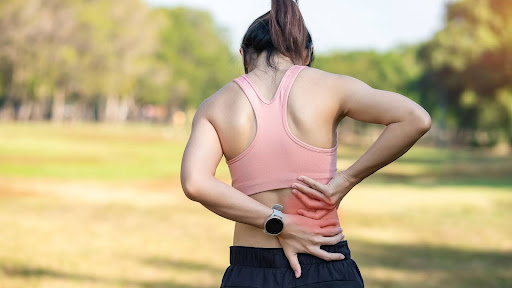Understanding and Managing Pain in 2025: Insights by Dr. Ekta Gupta
In this guide, I will explain common pain conditions, their causes, some ways to manage them at home and modern treatment options, so you can make informed decisions about your health.
1. Back Pain, Disc Prolapse, and Sciatica

Overview:
Back pain is the most common musculoskeletal complaint worldwide. Disc prolapse occurs when the soft disc material between vertebrae pushes out, sometimes compressing spinal nerves, causing sciatica, which manifests as pain radiating from the lower back down the legs.
Causes:
- Poor posture especially prolonged sitting
- Degenerative changes with age
- Sedentary lifestyle or obesity
- Heavy lifting or improper movements
Modern Treatments (2025 Trends):
- Regenerative therapies (PRP, stem cells): Stimulate healing of spinal tissues.
- Teleconsultation through DocGenie: Follow-up care from home.
- Targeted physical therapy: Core strengthening, flexibility exercises, and postural correction.
- Neuromodulation therapy: Non-invasive treatment to relieve nerve pressure.
Home Management Tips:
- Use ergonomic chairs and maintain a neutral spine while sitting.
- Practice daily stretching and low-impact exercises like yoga or walking.
- Avoid prolonged bed rest; gentle movement promotes healing.
Read More:- Complete Guide to Back Pain
2. Shoulder Pain

Overview:
Shoulder pain can result from rotator cuff injuries, frozen shoulder (adhesive capsulitis), arthritis, or overuse. It limits arm movement and daily activities.
Causes:
- Repetitive overhead movements in work or sports
- Rotator cuff tears or tendonitis
- Arthritis or inflammation of shoulder joints
Modern Treatments:
- Regenerative therapy - helps repair defects in rotator cuff (muscles of shoulder)
- Peripheral nerve stimulation (PNS): Reduces nerve-mediated pain.
- Physical therapy & strengthening exercises to restore mobility.
- Minimally invasive shoulder surgery for severe cases.
Home Tips:
- Perform gentle range-of-motion exercises daily.
- Apply heat or cold packs to reduce inflammation.
- Avoid lifting heavy objects overhead until pain resolves.
3. Knee Pain

Overview:
Knee pain is increasingly common, even in younger adults, due to injuries, obesity, and active lifestyles. It may result from arthritis, ligament or meniscus injuries.
Causes:
- Osteoarthritis or degenerative joint disease
- Sports injuries or accidents
- Overweight or imbalance in leg muscles
Modern Treatments:
- Genicular nerve ablation: Minimally invasive procedure for chronic knee pain
- Regenerative therapies (PRP, stem cells): Promote cartilage and tissue healing.
- Robotic-assisted surgeries: Precision in knee replacement procedures.
Home Management:
- Weight management to reduce knee load.
- Low-impact exercises like swimming or cycling.
- Use supportive footwear and knee braces if recommended.
4. Leg and Heel Pain

Overview:
Heel pain, such as plantar fasciitis, and general leg pain affect mobility, posture, and comfort while walking or standing.
Causes:
- Flat feet or high arches
- Repetitive strain from running or long-standing hours
- Nerve compression or inflammation of connective tissues
Modern Treatments:
- Shockwave therapy: Stimulates healing in the plantar fascia.
- Targeted physiotherapy: Stretching and strengthening exercises.
- Regenerative and prolotherapy : this strengthens the weak foot fascia and helps regain back movement
Home Tips:
- Daily calf stretches and foot exercises.
- Supportive footwear with cushioning.
- Ice therapy for inflammation.
5. Nerve Pain

Overview:
Nerve pain (neuropathic pain) can be debilitating and occurs due to nerve damage or irritation. This includes conditions like trigeminal neuralgia, diabetic neuropathy, and post herpes/shingles nerve pain.
Causes:
- Diabetes or metabolic disorders
- Trauma or surgery
- Compression or inflammation of nerves
- Poor immunity
Modern Treatments:
- Neuromodulation therapies: Electrical impulses modulate nerve signals.
- Radiofrequency nerve ablation: For chronic facial pain especially trigeminal neuralgia
- Supplements: B-complex vitamins, alpha-lipoic acid to support nerve health.
Home Management:
- Avoid tight clothing or pressure on affected nerves.
- Gentle stretching and ergonomic positioning.
- Online Consult a specialist early via DocGenie to prevent worsening.
6. Post-Surgical Pain
Overview:
Post-surgical pain can delay recovery, affect mobility, and impact quality of life if not managed effectively.Modern Approaches:
- Multimodal analgesia: Combines medications, local injections, and non-drug therapies.
- Enhanced Recovery After Surgery (ERAS): Focuses on reducing opioids and accelerating recovery.
- Teleconsultations through DocGenie for monitoring pain and healing remotely.
Home Tips:
- Follow prescribed exercises and rehabilitation protocols.
- Monitor wound healing and report unusual pain or swelling promptly.
- Use recommended pain-relief strategies under guidance.
7. Fibromyalgia
Overview:
Fibromyalgia is a chronic pain condition involving widespread body pain, fatigue, and sleep disturbances.
Causes:
- Exact cause unknown; involves nervous system sensitization
- Stress, trauma, or hormonal imbalances may worsen symptoms
Modern Treatments:
- Mindfulness, meditation, and cognitive behavioral therapy (CBT)
- Tailored exercise programs focusing on low-impact movements
- Nutritional support to reduce inflammation
- Medications for nerve pain or sleep disturbances
Home Tips:
- Gentle daily activity and stretching
- Adequate sleep hygiene
- Stress management through mindfulness
8. Pelvic Pain
Overview:
Pelvic pain can result from musculoskeletal issues, nerve problems, or organ-related conditions. It affects both men and women and can be chronic.
Modern Treatments:
- Pelvic floor physical therapy
- CBT for chronic pain management
- Lifestyle adjustments like posture correction and weight management
- Nerve blocks to relieve nerve and organ related pain
Home Tips:
- Daily stretches and gentle strengthening exercisesAvoid prolonged sitting; take breaks to moveConsult Dr. Ekta Gupta via DocGenie for tailored interventions
9. Tailbone Pain (Coccydynia)
Overview:
Tailbone pain occurs due to trauma, prolonged sitting, or childbirth. It can interfere with daily sitting and mobility.
Modern Treatments:
- Cushioned seating to relieve pressure
- Posture correction and ergonomic adjustments
- Nerve block for longstanding severe cases
Home Tips:
- Use donut cushions or memory foam seating
- Take short breaks from sitting every hour
- Early consultation via DocGenie Pain specialist Dr Ekta Gupta helps prevent chronic issues
Tips for Managing Pain at Home in 2025
- Maintain good posture during work or long sitting hours.
- Include low-impact exercises like yoga, swimming, or walking.
- Use heat or cold therapy for temporary relief.
- Ensure adequate sleep to support healing.
- Eat an anti-inflammatory diet rich in fruits, vegetables, and omega-3s.
- Seek early guidance from specialists like Dr. Ekta Gupta via DocGenie for chronic or severe pain.



